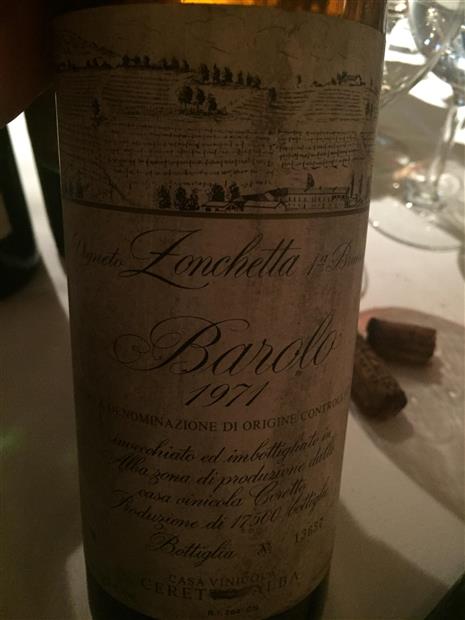
External search
Google (images)
Wine Advocate
Wine Spectator
Burghound
Wine-Searcher
Vintages
2019
2018
2017
2016
2015
2014
2013
2012
2011
2010
2009
2008
2007
2006
2005
2004
2003
2002
2001
2000
Show more
From this producer
Show all wines
All tasting notes
|
| Drinking Windows and Values |
| Community Tasting History |
| Community Tasting Notes (average 82.5 pts. and median of 82 pts. in 3 notes) - hiding notes with no text | | | Tasted by Gregory Dal Piaz on 9/19/2022 & rated 70 points: Clear, very pale tawny onion skin color. Rather earthy on the nose, with gentle hints of caramel, smoke, and dried dates. Retains some substance, you can feel the Brunate power here, this is pleasant, a touch simpler than the Grignore but also a touch less oxidative. A little apricot fruit graces the palate which is rather skeletal and built on assertive acids. Less gong for than the Grignore 70-72
After 4 hours:
Has picked up the slightest pink glow. Deeper and earthier on the nose, laced with autumnal scents and hints of limestone. Almost like a rose at this point, kind of pleasant with nice minerality and fleeting glimpses of red fruit. 71
With dinner:
Bright and fresh on the nose if mineral and predominantly dried underbrush notes on the nose. Theres so little here but at least itís not overtly oxidized. This is an xray of a wine. 70 (440 views) | | | Tasted by Zmirc on 1/23/2021: Smell a bit murky at first. Tastewise the wine started out hesitantly but gained momentum after some time. A hint of strawberry, but not much fruit left overall. Very pleasurable. On day two, the acidity had overpowered the other constituents. (605 views) | | | Tasted by derek.hara@sbcglobal.net on 5/18/2015 & rated 95 points: Amazing. So much fruit, structure and acidity left...drinking like a very balanced 96. Simply delicious...layers and layers of flavors; rose petals, anise, cigar, and leather wrapped up in silky lusciousness. Still can't believe this wine was 45 years old. (1618 views) |
| Ceretto Producer websiteNebbioloNebbiolo is a red grape indigenous to the Piedmont region of Italy in the Northwest. The grape can also be found in other parts of the world, though they are not as respected.
Nebbiolo is often considered the "king of red wines," as it is the grape of the famed wines of Barolo DOCG, Barbaresco DOCG, and Roero DOCG. It is known for high tannins and acidity, but with a distinct finesse. When grown on clay, Nebbiolo can be very powerful, tannic, and require long aging periods to reach its full potential. When grown on sand, the grape exhibits a more approachable body with more elegant fruit and less tannins, but still has high aging potential.
"Nebbiolo" is named for the Italian word, "nebbia", which means "fog", in Italian and rightfully so since there is generally a lot of fog in the foothills of Piedmont during harvest.
Nebbiolo is a late-ripening variety that does best in a continental climate that boasts moderate summers and long autumns. In Piedmont, Nebbiolo is normally harvested in October.
More links:
Varietal character (Appellation America) | Nebbiolo on CellarTrackerItaly Italian Wines (ItalianMade.com, The Italian Trade Commission) | Italian Wine Guide on the WineDoctorPiedmont Vignaioli Piemontesi (Italian only)
On weinlagen-infoLanghe Consorzio di Tutela Barolo Barbaresco Alba Langhe e Roero | Union of Producers of Albese Wines (Albeisa)BaroloRegional History:
The wines of Piedmont are noted as far back as Pliny's Natural History. Due to geographic and political isolation, Piedmont was without a natural port for most of its history, which made exportation treacherous and expensive. This left the Piedmontese with little incentive to expand production. Sixteenth-century records show a mere 14% of the Bassa Langa under vine -- most of that low-lying and farmed polyculturally. In the nineteenth century the Marchesa Falletti, a frenchwoman by birth, brought eonologist Louis Oudart from Champagne to create the first dry wines in Piemonte. Along with work in experimental vineyards at Castello Grinzane conducted by Camilo Cavour -- later Conte di Cavour, leader of the Risorgimento and first Prime Minister of Italy -- this was the birth of modern wine in the Piedmont. At the heart of the region and her reputation are Alba and the Langhe Hills. This series of weathered outcroppings south of the Tanaro River is of maritime origin and composed mainly of limestone, sand and clay, known as terra bianca. In these soils -located mainly around the towns of Barolo and Barbaresco -- the ancient allobrogica, now Nebbiolo, achieves its renowned fineness and power.
map of Barolo DOCG
An interesting thread on Traditional vs. Modern Barolo producers:
https://www.wineberserkers.com/forum/viewtopic.php?f=1&t=106291 |
|




